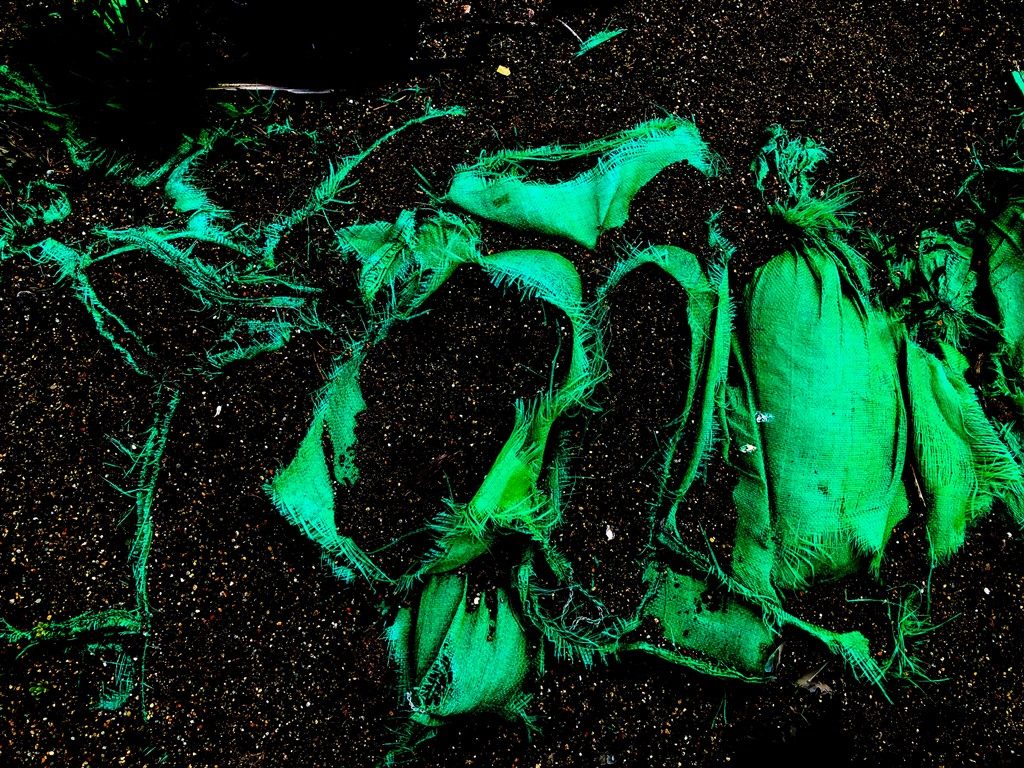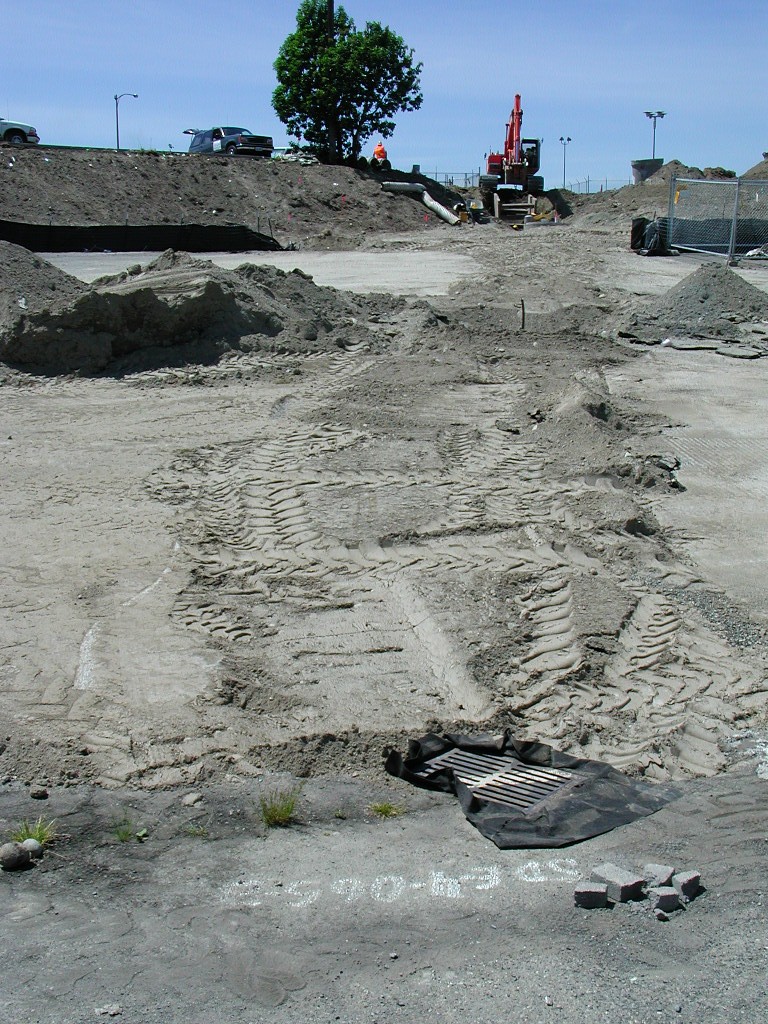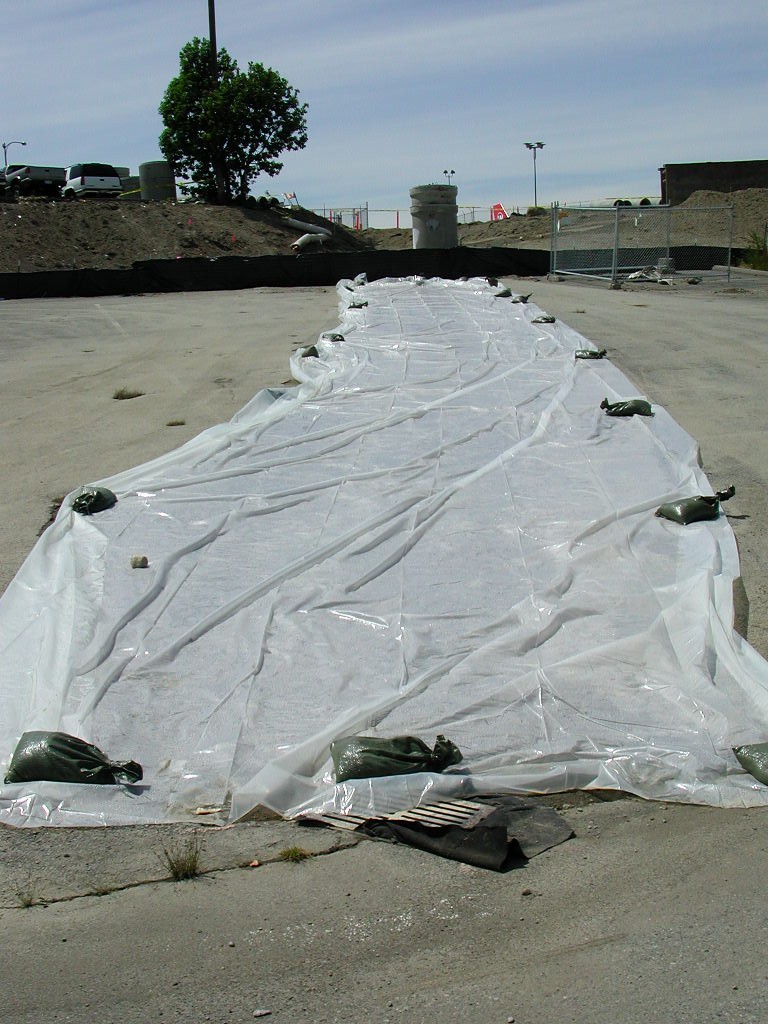
Blowin’ in the wind is what happens to your plastic stockpile cover when you don’t use enough sand bags. The contractor has been pulling material from the pile daily and hasn’t been using enough sand bags on the overlapped seams.

Blowin’ in the wind is what happens to your plastic stockpile cover when you don’t use enough sand bags. The contractor has been pulling material from the pile daily and hasn’t been using enough sand bags on the overlapped seams.
Here is a nice, plastic covered slope. They have placed sand bags on the seams, the seams are overlapped at least 12 inches and the plastic is run all the way to the bottom of the slope. This is a riverbank habitat restoration project on the Duwamish Waterway.

We have covered a slope above the Duwamish Waterway with plastic until landscaping occurs in December. The contractor has done a great job overlapping the plastic sheets and securing them with sand bags.

It’s a BMP graveyard. Ten year old sand bags; like we need even more micro-plastic laying around.

Ten year old sand bags and micro-plastic left in the environment.

Whenever I see something like this, it makes me think that the site owner/contractor either didn’t know what they were doing or bit off more project than they could chew, or both. These guys cleared, grubbed and graded something over 80 acres starting in late summer, failed to phase the work, failed to use soil cover practices, failed to listen to the experts and got nailed by the fall rains.
Erosion control is really about water control: reducing volume, preventing it from becoming turbid, and controlling where it goes. By the time the rains hit this project, there was too much water, it was too dirty, and there were too few options for controlling where it went.
In addition, they refused to set up a chitosan-enhanced sand filtration system to treat and discharge water; this left them no options and too much turbid water that had nowhere to go. As a result, they hammered a wetland, were fined heavily, and were shut down for months.
Silt fences are not meant to control water, convey water, filter water; they are designed to control eroded sediment. Ditches, berms (rock, gravel, triangular silt dikes, etc.) would have been better choices at this location. Not opening up so much area so late in the season would have been the best option. Their means and methods did not save them time or money.

I was just minding my own business last Friday, driving from Fred Meyer to the UPS store and passed this project. I told my wife I have to get a photo; she says okay since she knows me and my habit of stopping to take TESC photos.
I made a u -turn at the Wal Mart, drove back a block and stopped in the middle of the street to get this shot.
There is so much wrong here, where do I start? Clearly, dirt is tracked off of the project in the background, as you can see the sediment build up in the curb line. Someone told someone to put something in the swale to keep dirt out, then someone else installed this silt fence.
First off, silt fence needs to be trenched in and this just has a few rocks placed on the flap.
Second, they probably couldn’t trench this in anyway without tearing up the drainage swale.
Third, only two of the three curb cuts are backed by the silt fence.
Fourth, silt fence is a barrier, not a filter, and with the volume of water draining off the asphalt during a rain event, dirty water would just blow around and under the silt fence.
Conclusion, silt fence is never used in a water flow situation; it is only to contain eroded sediment from a sloped area. A better BMP here is a compost berm or something similar that would allow some water to pass but filter some sediment. Sand bags would work to keep everything out of the swale but then the dirty water would bypass to the next catch basin, which probably has a catch basin insert, which would collect sand and such but would not do anything for turbidity. So, what is the best BMP? Stop the !@#$ ing trackout in the first place!


The contractor had to connect a new storm system from up the hill into an existing catch basin in the foreground. After they completed the connection but before paving, they covered the pipe run with plastic and sand bags to protect from dirty water entering the catch basin. Work was completed during dry summer weather. Paving took place a couple of months later.
I saw this excellent stockpile on a waterfront construction project and had to shoot a video.
Powered by WordPress